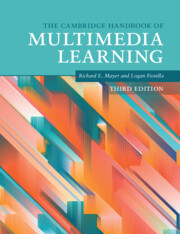Book contents
- The Cambridge Handbook of Multimedia Learning
- The Cambridge Handbook of Multimedia Learning
- Copyright page
- Contents
- Figures
- Tables
- Contributors
- Preface
- Acknowledgments
- Part I Background
- Part II Theoretical Foundations
- Part III Basic Principles of Multimedia Learning
- Part IV Principles for Reducing Extraneous Processing in Multimedia Learning
- Part V Principles for Managing Essential Processing in Multimedia Learning
- Part VI Principles Based on Social and Affective Features of Multimedia Learning
- Part VII Principles Based on Generative Activity in Multimedia Learning
- 28 The Generative Activity Principle in Multimedia Learning
- 29 The Mapping Principle in Multimedia Learning
- 30 The Drawing Principle in Multimedia Learning
- 31 The Imagination Principle in Multimedia Learning
- 32 The Self-Explanation Principle in Multimedia Learning
- 33 The Guided Inquiry Principle in Multimedia Learning
- 34 The Feedback Principle in Multimedia Learning
- 35 The Learner Control Principle in Multimedia Learning
- 36 The Cognitive Load Self-Management Principle in Multimedia Learning
- Part VIII Multimedia Learning with Media
- Author Index
- Subject Index
- References
34 - The Feedback Principle in Multimedia Learning
from Part VII - Principles Based on Generative Activity in Multimedia Learning
Published online by Cambridge University Press: 19 November 2021
- The Cambridge Handbook of Multimedia Learning
- The Cambridge Handbook of Multimedia Learning
- Copyright page
- Contents
- Figures
- Tables
- Contributors
- Preface
- Acknowledgments
- Part I Background
- Part II Theoretical Foundations
- Part III Basic Principles of Multimedia Learning
- Part IV Principles for Reducing Extraneous Processing in Multimedia Learning
- Part V Principles for Managing Essential Processing in Multimedia Learning
- Part VI Principles Based on Social and Affective Features of Multimedia Learning
- Part VII Principles Based on Generative Activity in Multimedia Learning
- 28 The Generative Activity Principle in Multimedia Learning
- 29 The Mapping Principle in Multimedia Learning
- 30 The Drawing Principle in Multimedia Learning
- 31 The Imagination Principle in Multimedia Learning
- 32 The Self-Explanation Principle in Multimedia Learning
- 33 The Guided Inquiry Principle in Multimedia Learning
- 34 The Feedback Principle in Multimedia Learning
- 35 The Learner Control Principle in Multimedia Learning
- 36 The Cognitive Load Self-Management Principle in Multimedia Learning
- Part VIII Multimedia Learning with Media
- Author Index
- Subject Index
- References
Summary
Feedback is widely considered an effective instructional technique that improves learning outcomes across a variety of multimedia learning environments, including interactive lessons, educational games, and simulations. The effectiveness of feedback depends on a number of factors, and in this chapter we focus on the content of the feedback message and compare corrective and explanatory feedback. Corrective feedback informs learners whether they were right or wrong, and explanatory feedback provides learners with an explanation for why their response was correct or incorrect. The feedback principle states that novices learn better with explanatory feedback than corrective feedback alone. In this chapter, we present evidence concerning the feedback principle, discuss boundary conditions that can limit its effectiveness, and explore adaptive training as an approach to mitigate some of these boundary conditions.
Keywords
- Type
- Chapter
- Information
- The Cambridge Handbook of Multimedia Learning , pp. 403 - 417Publisher: Cambridge University PressPrint publication year: 2021
References
- 3
- Cited by

